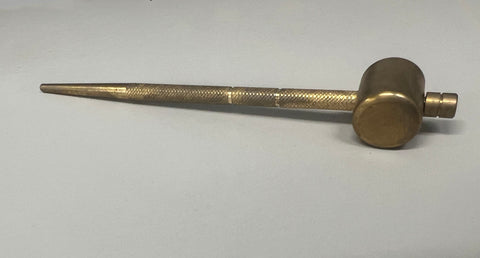Welcome to the world of katana ownership! Armed with your first sword, you're likely wondering, "how do I clean a katana?" With proper care and regular sword maintenance, your katana can last indefinitely. This article will guide you through the steps of cleaning a katana, including essential tips for preserving your blade's integrity.
How Often Should You Clean a Katana?
A blade made from carbon steel is susceptible to rust, so regular oil application is crucial for sword cleaning. The frequency of oiling depends on both environmental conditions and usage:
-
Dry climates: every 3-4 months
-
Humid climates: every 1-2 months
-
After each use
What's in a Katana Maintenance Kit?
Here's what you will typically find in a maintenance kit:

Chōji oil: This oil protects the blade from corrosion or discoloration.

Uchiko ball: A silk ball filled with powder, useful for removing oil and scratches from the blade.

Mekuginuki: A small, hammer-like tool that helps remove the mekugi pegs from the katana for deep cleaning.

Nuguigami cloths: Cloths made from rice paper for cleaning oil, dust, and powder from the blade.

Storage container: A container for storing your oiling cloth.
The Step-by-step Guide to Clean a Katana
Step 1:
Gently remove your blade from its sheath, using extreme caution.
Step 2:
Use a lint-free wiping cloth to eliminate old dirt and oil. Fold the cloth over the blade, ensuring complete coverage of the flat surfaces, with the sharp edge facing away from you. Starting near the hilt, hold the blade firmly within the cloth and run it along the entire blade length. Repeat this until the blade is clean.
Step 3:
Gently tap the uchiko ball onto the entire flat surface of the blade. Repeat this process on the opposite side and the top edge. Once an even layer of powder covers both sides and the top edge, use a clean cloth to remove all the powder. At this point, the blade should be free of oil and powder; avoid touching it with bare hands. Using the uchiko ball is not necessary for every cleaning - once or twice a year or after heavy usage is sufficient.
Step 4:
Apply a small amount of mineral oil or Choji oil using an oiling cloth. As in previous steps, ensure the sharp edge is away from you before running the cloth along the blade. Repeat this until the blade is evenly coated with a light layer of oil. Avoid applying excess oil near the Habaki (the blade collar), as it can cause build-up.
Step 5:
Conduct a final check for dry spots or missed areas. Once the blade is completely dry and well-oiled, re-sheath your katana and store your cleaning tools properly. The oiling cloth from Step 4 can be stored in a small plastic container to keep it clean and ready for future use.
Tips and Tricks for Katana Maintenance
-
Avoid harsh chemicals or abrasive materials that can harm the blade.
-
Avoid touching the blade directly. Skin oil can cause rust; always use a cloth to handle the blade.
-
Pay attention to weather changes if you live in an area with drastic climate variations - your katana cleaning schedule may need adjustment.
-
Always ensure you're alert and focused when cleaning your katana. If you're tired, distracted, or unwell, postpone the cleaning to avoid potential accidents. Remember, a katana is a weapon and should be handled with respect and caution.
Alternative Cleaning Tools for Your Katana
Sometimes, you might need to improvise with the materials you have at hand. If your usual oiling cloth is unavailable, a lint-free flannel cloth or even a paper towel can substitute in a pinch for applying oil. However, always ensure that these are clean and free from abrasive particles to avoid scratching your katana. If you're looking for an alternative to mineral or Choji oil, clove oil is a viable option. It's often used in the maintenance of swords and other blades due to its protective and rust-preventing properties. When cleaning the intricate parts of your katana, such as the bo-hi or the handle made of wood, a clean, dry stick can help dislodge dirt or dust. But remember, improvisation should be a temporary solution. For regular maintenance, it's best to use the appropriate tools to preserve the longevity and condition of your katana.
Special Considerations for Katana Maintenance
-
In humid climates, it's essential to clean a katana more frequently to prevent moisture-related damage and rust.
-
Make sure the mekugi pegs, the small bamboo pins holding the handle to the blade, are in good condition. Damaged or loose mekugi can lead to accidents during cleaning or usage.
-
Check the bo-hi, the groove running along the flat part of the blade, for any residue or build-up. Use a soft, lint-free cloth to gently clean this area.
-
The edge of your katana is the most vulnerable to rust. Pay particular attention to it during your maintenance routine.
-
Always wipe and oil your katana in one direction to prevent micro-scratches on the blade.
-
Always use a clean, lint-free cloth for oiling. If your oil cloth becomes dirty or worn, replace it to prevent scratching or contaminating the blade.
With these guidelines, you can ensure your katana remains sharp, clean, and in optimal condition. Regular sword maintenance is an essential part of owning a katana and allows you to appreciate the fine craftsmanship and history embodied in your sword. Remember, a well-cared-for katana can last for generations, becoming a treasured heirloom for your descendants.
-
Script: no
